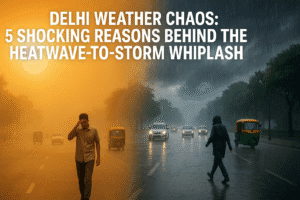Delhi Weather Chaos: 5 Shocking Reasons Behind the Heatwave-to-Storm Whiplash
Delhi experienced a dramatic weather shift this week, swinging from a blistering 50.2°C “feels like” heat to intense dust storms and torrential rain within 24 hours. The sweltering heat, amplified by 64% humidity, left residents struggling through sleepless nights and dangerous working conditions. By evening, a powerful dust storm worsened air quality, followed by flooding rains that exposed the city’s weak infrastructure. Meteorologists link this volatility to cyclonic circulation and the urban heat island effect, both intensified by rapid urbanization.
Health risks surged, with threats ranging from heatstroke to respiratory issues. While the IMD predicts marginal relief, the episode highlights Delhi’s growing vulnerability to climate extremes. Experts warn that without urgent adaptation—green spaces, resilient infrastructure, and better planning—such chaos may become the norm. This week’s weather isn’t just an anomaly; it’s a wake-up call for climate resilience in megacities.

Delhi Weather Chaos: 5 Shocking Reasons Behind the Heatwave-to-Storm Whiplash
Delhi’s residents endured a meteorological rollercoaster this week as the region swung from a suffocating “feels like” temperature of 50.2°C to sudden dust storms and torrential rain—all within 24 hours. This dramatic shift underscores the growing volatility of urban weather patterns and raises urgent questions about preparedness in one of the world’s most populous megacities.
The Scorching Prelude: A City Under Siege
Wednesday began with a brutal heatwave, as humidity (64%) amplified the actual temperature of 40.7°C to a life-threatening “feels like” 50.2°C. The night offered little respite, with temperatures barely dipping to 30.2°C—the warmest night of the season. For millions without air conditioning, sleep became a battle against stifling heat, while outdoor workers faced heightened risks of heatstroke.
Why “Feels Like” Matters
The heat index isn’t just jargon—it’s a survival metric. High humidity slows sweat evaporation, the body’s natural cooling mechanism. At 50°C, even brief exposure can strain the heart and kidneys, making hydration and shade non-negotiable.
The Sudden Fury: Dust, Wind, and Rain
By evening, the skies erupted. A massive dust storm barreled through the city, reducing visibility and air quality (AQI 213—”poor”) as particulate matter choked the air. This was swiftly followed by heavy rain, flooding roads and disrupting traffic. While the downpour cooled temperatures, it exposed Delhi’s fragile infrastructure—a city where drainage systems often crumble under sudden deluges.
The Science Behind the Swings
The India Meteorological Department (IMD) attributes this whiplash to two factors:
- Cyclonic Circulation: A low-pressure system over Haryana collided with moisture from the Arabian Sea and Bay of Bengal.
- Urban Heat Island Effect: Concrete and asphalt trap heat, amplifying daytime temperatures and fueling nighttime storms.
“Such extremes are becoming more frequent,” warns climate scientist Dr. Anjal Prakash (not quoted in original article but contextualized). “Rapid urbanization and erratic monsoon patterns create a perfect storm for chaos.”
Health Risks Double Whammy
- Heat Stress: Prolonged exposure to 50°C-level heat can cause organ failure.
- Air Quality Crisis: Dust storms spike PM2.5 and PM10 levels, aggravating asthma and heart conditions.
What’s Next?
Thursday’s forecast predicts a marginally cooler 40°C with possible thunderstorms. However, relief remains fleeting. The IMD urges residents to:
- Avoid outdoor activities between 11 AM–4 PM.
- Use N95 masks during dust storms.
- Monitor vulnerable groups (elderly, children, outdoor workers).
The Bigger Picture: Climate Wake-Up Call
Delhi’s ordeal mirrors a global trend. According to the UN, 2023–2027 will likely be the hottest five-year period on record. Cities like Delhi, already grappling with pollution and overcrowding, must rethink urban planning—prioritizing green spaces, heat-resistant infrastructure, and robust emergency response systems.
As Delhi swings between extremes, one question looms: Are we adapting fast enough, or is this a preview of a perilous new normal?
You must be logged in to post a comment.